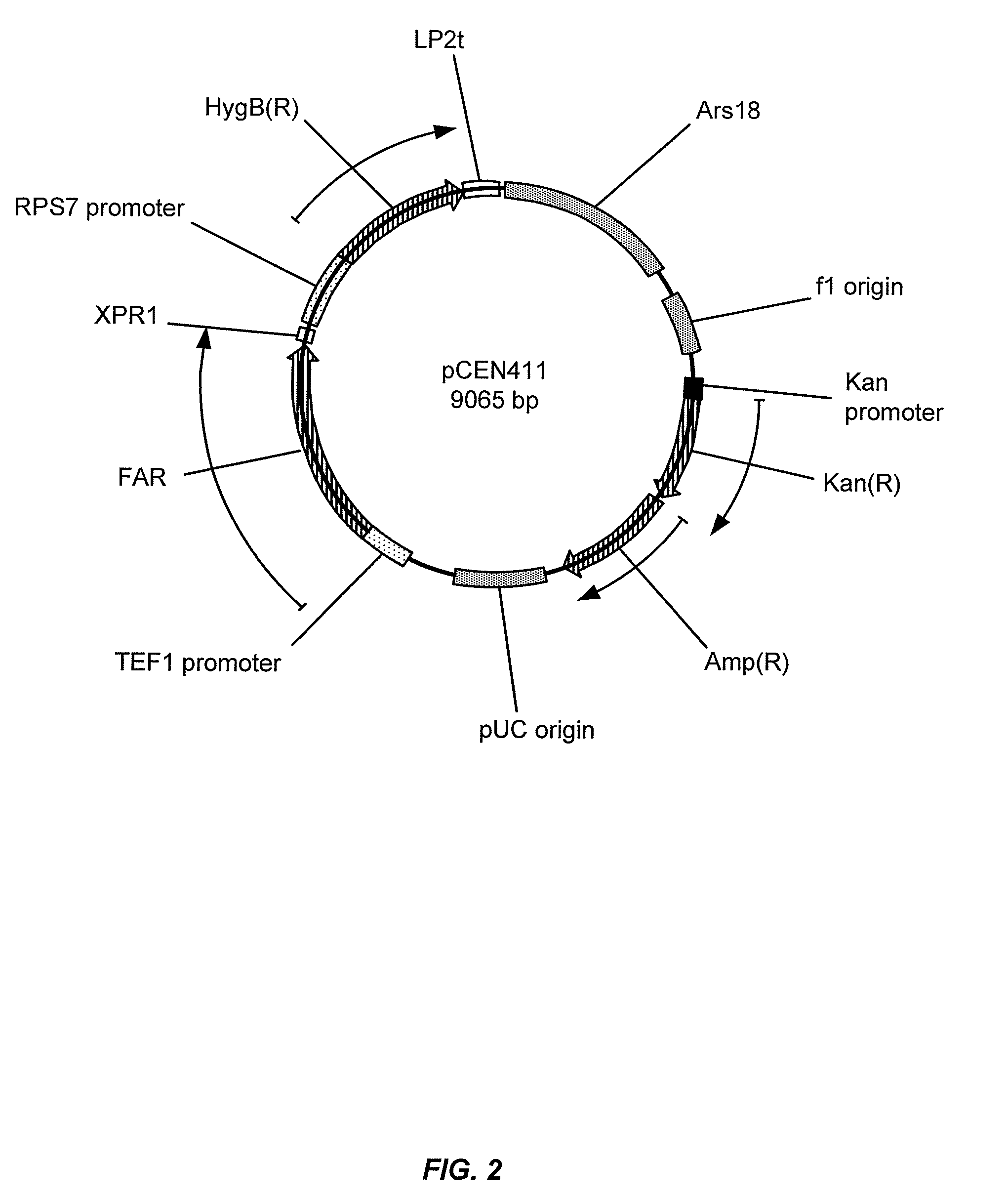Gene disruptants producing fatty acyl-CoA derivatives
a technology of acyl-coa and microbial organisms, which is applied in the field of gene disruptants producing fatty acyl-coa derivatives, can solve the problems of commercial production and recovery of fatty alcohols from microbial organisms, and achieve the effect of improving the production of fatty acyl-coa derivatives
- Summary
- Abstract
- Description
- Claims
- Application Information
AI Technical Summary
Benefits of technology
Problems solved by technology
Method used
Image
Examples
example 1
Expression of Wild-Type M. algicola DG893 FAR in Y. lipolytica Strains
[0285]Wild-type FAR from M. algicola (FAR_Maa) was expressed in Y. lipolytica strains. The sequence of the codon optimized M. algicola DG893 FAR gene corresponds to SEQ ID NO:1, and the corresponding polypeptide sequence is designated SEQ ID NO:2. An autonomous replicating plasmid, pCEN354, was constructed for expression of the M. algicola DG893 FAR gene in Y. lipolytica strains. The replicating plasmid was engineered with two antibiotic selection marker cassettes for resistance to hygromycin and phleomycin (HygB(R) or Ble(R), respectively). Expression of each cassette is independently regulated by a strong, constitutive promoter isolated from Y. lipolytica: pTEF1 for Ble(R) expression and pRPS7 for HygB(R) expression. Plasmid pCEN354 was used to assemble Y. lipolytica expression plasmids. Using “restriction free cloning” methodology, the Ble(R) gene was replaced with the M. algicola DG893 FAR gene to provide the ...
example 2
In Vivo Activity of Exogenous M. algicola FAR in Recombinant Y. lipolytica Strains
[0289]Two Y. lipolytica strains were used for constructing gene knockouts: 1) Y. lipolytica DSMZ 1345 obtained from the German Resource Centre for Biological Material (DSMZ), and 2) Y. lipolytica CY-201, an improved production host obtained by UV-mutagenesis of Y. lipolytica DSMZ 1345 and defective in growth on media with hexadecane as the sole carbon source. When transformed with pCEN411, Y. lipolytica CY-201 produced 7- to 10-fold more fatty alcohols compared to Y. lipolytica DSMZ 1345 and also significantly reduced the rate of degradation of exogenous 1-hexadecanol in YPD media containing 8% glucose and 500 μg / mL hygromycin. The expression of alternative FAR genes and variants in modified Y. lipolytica strains can be assessed using similar methodology.
example 3
Analysis of Fatty Alcohol Production in Y. lipolytica Strains Containing Exogenous FAR
[0290]Y. lipolytica strains comprising a plasmid containing an exogenous gene encoding M. algicola DG893 FAR were grown in 96-well Axygen plates containing 250 μL YPD supplemented with 2% glucose and 500 μg / mL hygromycin. Plates were incubated in a Kuhner shaker-incubator for approximately 40-48 hours at 30° C., 200 rpm and 85% relative humidity. The cell cultures were diluted by transferring 50 μL of overnight grown cultures into the Axygen 96-well plates containing 250 μL YPD supplemented with 2% glucose and 500 μg / mL hygromycin. The plates were incubated for approximately 24-28 hours in a Kuhner shaker-incubator under the same conditions. 20 μL of the cell cultures were transferred into deep 96-well plates containing 380 μL YPD supplemented with 8% glucose and 500 μg / mL hygromycin. The plates were incubated for approximately 22-26 hours under the same conditions. Cells were collected by centrifu...
PUM
| Property | Measurement | Unit |
|---|---|---|
| temperature | aaaaa | aaaaa |
| temperature | aaaaa | aaaaa |
| length | aaaaa | aaaaa |
Abstract
Description
Claims
Application Information
 Login to View More
Login to View More - R&D
- Intellectual Property
- Life Sciences
- Materials
- Tech Scout
- Unparalleled Data Quality
- Higher Quality Content
- 60% Fewer Hallucinations
Browse by: Latest US Patents, China's latest patents, Technical Efficacy Thesaurus, Application Domain, Technology Topic, Popular Technical Reports.
© 2025 PatSnap. All rights reserved.Legal|Privacy policy|Modern Slavery Act Transparency Statement|Sitemap|About US| Contact US: help@patsnap.com



